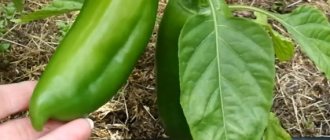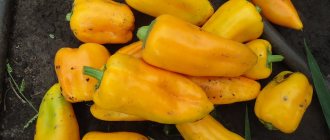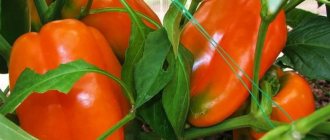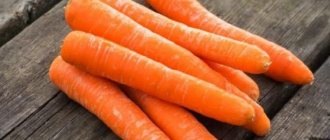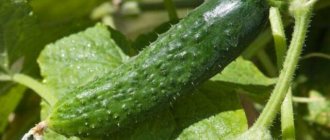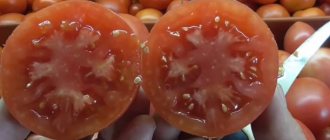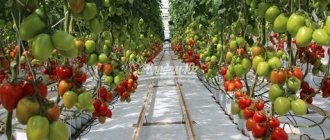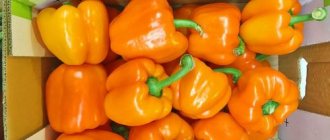In almost any homestead, vegetable growers strive to grow vegetables for personal consumption. The range of crops invariably includes bell pepper. Many gardeners opt for early and productive Dutch hybrids. One such variety is the Gypsy F1 pepper. This relatively new hybrid has excellent qualities that make it a good choice for any gardener. Find out about them and join the fans of this pepper.
What kind of pepper is this
Let's take a closer look at what Gypsy pepper is, its main characteristics and distinctive features.
Hybrid F1
The Gypsy F1 hybrid was launched in 2005 by the Dutch company Monsanto Holland. Pepper seeds are supplied to the Russian market by Semenis. In 2007, the hybrid was included in the State Register of Breeding Achievements used for cultivation in the Russian Federation.
This pepper is most often planted in gardens and gardens. Subject to compliance with agricultural technology and care rules, it is recommended for cultivation in the Urals and Siberia (under film cover).
Characteristics and description of the hybrid
Gypsy belongs to the early maturing Dutch hybrids . The first fruits appear 60 days after the seedlings are planted in the beds. The hybrid is intended for cultivation in a greenhouse and in open ground.
Gypsy pepper has a universal table purpose . It is eaten fresh, used in the preparation of various dishes and canned.
Distinctive features
The bushes of the plants grow of medium size , the branches are semi-spreading, the stems are not strong.
Attention! To prevent the pepper from falling from gusts of wind and under the weight of the fruit, immediately after planting it is called to a support peg.
The foliage of pepper is bright green.
Fruit characteristics, yield
The fruits of the Gypsy hybrid are not large, but their shape is even . The average weight of one pepper is 110 g. Length - 10-11 cm, width - 5-6 cm.
Features of the fruit:
- the skin is thin but dense;
- the shape is cone-shaped, gradually tapering upward;
- walls 5-6 mm thick;
- the pulp is juicy, crispy;
- the taste is sweet, without bitterness or pungency;
- Resistant to cracking.
Important! Peppers are technically ripe when they turn yellow. Only fully ripened fruit has a bright red color.
The Gypsy hybrid is consistently productive . During the season, from one plant you can harvest from two to 2.5 kg of pepper.
Pepper Gipsy F1 (Seminis) crop in the field
Characteristics of the variety
The Gypsy pepper variety is an ultra-early variety; the first fruits reach biological maturity 55-65 days from the moment the seedlings are planted. To obtain an early harvest in a greenhouse, seeds are sown in early February and no picking is carried out.
It has a stable yield; from one bush you can harvest 2-2.5 kg of pepper per season. The variety is suitable for growing in greenhouses and open ground. It has a universal table purpose, suitable for fresh consumption, cooking and canning.
Description of the bush
The bush of this variety is low, reaching a height of 50-60 cm, with medium branching. The stems are fragile and prone to mechanical damage. The superficial root system is located in the ground no deeper than 25-30 cm. The leaves are medium-sized, wide, rich green in color. The shape of the leaf plate is elongated, the surface is smooth.
The bush blooms 60-70 days after sowing. The flowers are small, white, male and female. Flowering is long lasting and does not stop until frost. By nature, peppers are self-pollinating plants, but cases of cross-pollination are possible. It is often cross-pollinated with hot pepper, so it is better to plant such species in different beds at a distance of at least 10 m from each other.
Description of the fruit
The fruits of the Gypsy variety are not large-fruited, but have a beautiful, even shape and uniform size throughout the entire crop. The average weight is 100-120 g, it is 10-12 cm long and 5-6 cm wide.
Characteristic differences of the fruit:
- the skin is thin, dense with a waxy sheen;
- conical shape, evenly tapered towards the tip;
- wall thickness 4-6 cm;
- the pulp is crispy and homogeneous;
- divided into three chambers;
- seeds are light yellow;
- the taste is sweet, contain 7.5% sugar.
Peppers are considered technically ripe when they turn a creamy yellow color; when fully ripe, the fruit is deep red in color. Gypsy pepper seeds have a good germination rate of 75-80%.
Sweet pepper Gipsy f1, according to the description, is undemanding in care, but proper agricultural technology will allow you to get well-developed bushes, high yields and even, regularly shaped fruits. Peppers need regular moderate watering, loosening the soil, weeding, fertilizing and staking.
Watering and loosening
The first watering is carried out at the time of planting seedlings. The planting holes are shed with water, and when the moisture has been absorbed, young plants are planted. After 3-5 days, watering is repeated.
Throughout the season, the bushes are watered once a week until mass fruiting occurs. When the first batch of fruits has started, watering is stopped. Resume after harvesting at the beginning of re-flowering.
Among the basic rules of high-quality watering, the following should be highlighted:
- Water for irrigation should be settled and warm (above 22°C).
- Watering is carried out in the morning or evening.
- Water the bushes at the roots carefully so as not to erode the soil.
- To water one bush, 2-2.5 liters of water is enough.
Loosening the soil has a beneficial effect on growth. This will help saturate the earth with oxygen, which improves gas exchange processes and increases the supply of nutrients.
Loosening is carried out after watering. And also after the rain. The depth of loosening depends on the stage of plant development. Before flowering, loosening of row spacing is carried out to a depth of 5-7 cm. When the bushes begin to bloom, increase the loosening depth to 10 cm, and by the period of fruiting to 14 cm, and gradually reduce to 5-7 cm.
Pepper requires mandatory feeding
Gypsy f1 pepper grows well when it is provided with sufficient nutrients. Fertilizing is carried out three times during the growing season. This will be enough to provide the plants with the required amount of microelements.
- 20-25 days after planting the seedlings.
- At the beginning of mass fruiting.
- Two weeks after the second.
It is better to apply fertilizers in liquid form during the growth period. Organic and mineral fertilizers are suitable for feeding peppers. During the fruiting period, it is better to use organic fertilizers, as it is environmentally friendly.
To fertilize plants, you can use herbal infusion, manure, bird droppings, and mineral fertilizers.
- Herbal infusion. To prepare, take 2-3 kg of various fresh herbs (nettle, dandelion, lawn grass, medicinal herbs), add 10 liters of water and leave for 5-7 days to ferment. The finished infusion is mixed with water in a ratio of 1:10 and the bushes are watered or sprayed.
- Bird droppings. Chicken or pigeon is good; 250 g of droppings are enough for 10 liters of water. The solution is infused for 3-5 days, stirred occasionally. Add 0.5 liters of prepared bait to a bucket of water. Water around the bush at a distance of 20-30 cm from the trunk, avoiding getting on the leaves.
- Mineral fertilizers. Superphosphate is used together with urea. Take 10 g of each fertilizer and dissolve it in 10 liters of water. Water the bushes in the afternoon. For one bush, ½ liter of solution is enough.
It is important to remember that all fertilizing must be applied to pre-moistened soil, and the dosage must be maintained during preparation.
Tying up
This variety requires garter. According to the description, Gypsy f1 bushes have fragile stems that can be damaged by the weight of the fruit and the wind. To tie up the plants near each bush at the time of planting the seedlings, install a support. For this variety, it will be enough to drive stakes 60-70 cm high. The main stem is tied with fabric strips in several places at different heights. There is no need to strongly pull the stem to the support; the garter should hold the plant, but not limit free growth.
Preparation for cultivation
Before sowing, the seeds are dipped in a weak solution of potassium permanganate . Those that float up are thrown away, and the rest are washed under running water, dried and sown in prepared soil.
For Gypsy, as for many other varieties, sandy or loamy soil with lumps and humus is suitable.
It is better to plant pepper seeds for seedlings from mid-February to mid-March . It is then planted in the greenhouse around the end of May. But for open ground, seeds are planted several weeks later, planting seedlings in mid-June.
Gypsy pepper is considered unpretentious, but in order to get a large harvest, it is important to meet several conditions :
- Warm soil is preferable, so it is advisable to make beds that look like small mounds 40-50 cm high.
- Due to the low foliage of plants during the growing season, it is necessary to choose more shaded places so that the bushes and fruits do not burn from the bright sun.
Other Dutch hybrids:
Dutch hybrid pepper "Gemini f1"
Hybrid pepper “Claudio” and features of caring for it
How to care for seedlings
After pecking the leaves, the temperature is lowered to 12-16°C depending on the time of day (higher during the day, lower at night). It is necessary to ensure that the soil remains moist at all times. Seedlings are plucked when two full leaves grow.
During the period of seedling growth, it is necessary to make several feedings. Fertilizers are applied for the first time about a week after picking. The second feeding is carried out 10-12 days after the first. The third feeding is carried out a few days before transplanting the seedlings into the ground or into a greenhouse.
Growing seedlings
Growing pepper seedlings is not difficult if you know how to do it correctly.
Planting pepper
In the picking option, the seeds are planted in a common container in pre-moistened soil to a depth of 1 cm .
If without picking, then you need to plant them immediately in separate containers. To ensure reliable germination, you can take 2-3 seeds per dish and then leave the strongest plant. Then the container is covered with film and placed in a warm place - for example, near a radiator. Mostly, the seeds germinate within a week, sometimes a little more.
Afterwards, the film is removed and the seedlings are kept at a temperature of +16-18 °C during the day and +14 °C at night for a week. This is necessary to prevent the peppers from stretching and forming a powerful root system. During the rest of the period, the temperature is maintained within +18-25 °C.
Further care
Water the seedlings regularly as the top layer of soil dries. Picking is carried out only when the top two leaves grow.
During the period of plant growth, several feedings are done with mineral fertilizers. The first time - 7 days after picking, or 14 days after germination, if planted without picking. The second time is fed 11-12 days after the first time. The third time, fertilizers are applied a couple of days before transplanting the seedlings into open ground or a greenhouse.
Transplant the seedlings to a permanent place carefully so as not to break the fragile stems of the plant. Before planting, fertilizers are placed in the hole; humus is best. Peppers are planted in a row at a distance of about 30 cm from each other, and up to 50 cm are left between rows.
Important! During the flowering period, when the fruit begins to form, it is recommended to increase the frequency of watering.
Sweet pepper Gipsy: characteristics and description of the variety
The Gypsy bell pepper is classified as an ultra-early variety - it takes about 3 months from the moment the sprouts appear until the ripe fruits are harvested. Many vegetable growers say that from the moment the seedlings of this pepper are transplanted to a permanent place until the ripe fruits are harvested, about 2 months pass.
It is recommended to plant seedlings in a permanent place at the age of about 60 days, when at least 3 pairs of true leaves have appeared on the plants.
Pepper Gypsy F1 photo
Although vegetable growers have conflicting opinions about how long it takes from planting to harvesting this pepper, one thing is for sure - this variety is one of the earliest among all varieties of this vegetable crop in terms of fruit ripening.
The bushes can reach 0.45-0.5 m in height, quite compact, semi-spreading. The shoots are of medium thickness and not too powerful, so during the period of active ripening of the crop it is recommended to tie them to supports.
Important! The roots of this vegetable plant are very delicate, so they do not tolerate picking when grown in seedlings. Therefore, experts recommend planting seed material immediately in separate containers (preferably in peat cups).
The stems of this vegetable crop are medium leafy, the foliage is slightly wrinkled, its size is medium, and the color is deep emerald.
The ripe fruits are lowered downwards, of medium size, reaching 12-15 cm in length, and up to 6.5 cm in diameter. The weight of ripe peppers is 110-130 g with a wall thickness of about 4 mm.
The shape of ripening peppers is smooth, conical, and there can be up to three nests with seeds inside. The pulp is slightly crunchy, quite sweet, the fruits have no bitterness. The smell of ripe fruit is typical of pepper and is pronounced. The skin is quite durable and shiny. Ripe Gypsy peppers are greenish-yellow in color, but may also be waxy. During the ripening process, the color of the skin becomes deep scarlet.
Ripe peppers are used for stuffing, added to salads, and used in preservation (to prepare lecho, vegetable caviar).
The harvested crop tolerates transportation well over long distances and is characterized by high shelf life.
Yield of pepper Gypsy F1
When growing Gypsy pepper in open ground, up to 4-4.2 kg of ripe fruits are usually collected from one square. The number of ovaries appearing on a bell pepper bush depends on the weather; on average, 8-13 peppers can be set on each vegetable plant.
Since there are few leaves on the shoots, to prevent sunburn on the fruits, in hot weather the plants need to be shaded.
Video:
Features of cultivation and possible difficulties
First, you need to decide on the growing location and the exact time of planting in permanent soil.
According to many gardeners, the hybrid does not tolerate picks and transplants . Therefore, the best option is to plant the seeds in separate pots and peat containers. Pepper seedlings are not particularly powerful. But regular fertilizers and fertilizing stimulate the appearance of lush, dark greenery.
In a permanent place you need to plant no more than 6 plants per 1 square meter. m . It is advisable to immediately tie the bushes to the stakes so as not to add unnecessary stress to the flowering peppers.
Do not forget to regularly feed and water the crop .
Typical diseases and pests
Gypsy pepper is resistant to tobacco mosaic, but requires prevention against late blight and bacterial spot. For this, iodine and hydrogen peroxide are used. The bushes are sprayed every two to three weeks with a solution of iodine or peroxide at the rate of 15-20 ml of the drug per 10 liters of water.
The plant can be attacked by the following pests:
- spider mite;
- aphid;
- whitefly
To combat them, use folk remedies:
- Wormwood infusion . Take 200-250 g of dried wormwood and pour 10 liters of hot water. Leave for 30-40 minutes. Then spray the plants with liquid and water the beds.
- Infusion of onion peels . Take 100 g of husk per 5 liters of water. Leave the solution for 3-4 days, then process.
- Potato tops . The infusion is prepared from 3 kg of green leaves and potato stems, which are poured into 15 liters of warm water. All this is infused for 2-3 hours, then the pepper is sprayed.
Advantages and disadvantages of a hybrid
The benefits of pepper include:
- dense skin - ensures ease of transportation without loss of taste characteristics and presentation of the fruit;
- pleasant taste and aroma;
- big harvest;
- early ripening - 55-65 days after planting the plants in the beds;
- unpretentiousness;
- resistance to a number of diseases;
- cold tolerance.
Disadvantages of a hybrid:
- thin walls of the fetus;
- The harshness of peppers remains even after heat treatment.
Reviews
Summer residents generally respond positively to the hybrid ; there are only some complaints about the taste and thin stems of the plant.
Vladimir, Kovrov : “This hybrid did not disappoint me. I decided to buy a bag of seeds in the store to try. I grew seedlings from them, then planted them in the ground. The peppers turned out to be small and compact, but they had a lot of fruit. I liked their taste and shape. I will continue to plant it and I advise you to do the same.”
Maria, Chelyabinsk : “Gypsy pepper is very sweet. We've been friends with him for several years. Every year we are pleased with a large harvest. I mainly use it for salads and canning. I didn't notice any shortcomings. The hybrid is quite easy to care for. The only thing that can be noted is the need to install support pegs for each bush, otherwise the plants will break.”
Elena, St. Petersburg : “The pepper is not bad, but it’s too sweet, it’s not for everyone. It didn’t stay with me, but not because it’s bad, but because there’s something missing in the taste. In general, it has many advantages and is worth growing for those who are too early to plant more demanding varieties in their garden.”
Reviews from gardeners
According to gardeners, Gypsy pepper is one of the earliest ripening, high-yielding and unpretentious hybrids. He tolerates low temperatures well and rarely gets sick. The vegetable crop shows maximum productivity in closed ground conditions.
“I’ve been planting this hybrid in my garden for the 5th year now. The fruit sets perfectly. By the beginning of July, the bushes are hung with peppers. For a hybrid, Gypsy tastes great. The only thing I don't like about this pepper is the weak stems. They must be tied up, otherwise the bush will break under the weight of its fruits.”
“I plant only a few bushes of Gipsy F1 sweet pepper every year to get an early harvest. I mainly use it for fresh salads. I grow it in a greenhouse, so at the beginning of June our family is already eating peppers from our own plot.”
“Despite the fact that Gypsy is an early-ripening pepper, the timing of ripening still depends on weather conditions, at least in open ground. If the summer is very cold, then you won’t be able to get a harvest before the end of July.”
“Bell pepper is one of my favorite vegetables. I give preference to early varieties and hybrids, since mid-season and late-season varieties simply do not have time to ripen in our region with a short summer. Gypsy has been one of my favorites for many years now. First of all, I like it for its good yield; every bush is literally covered with peppercorns.”
